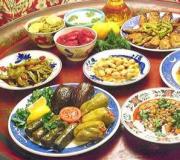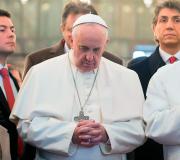What does metaphor mean in Russian examples. Metaphor as a type of figurative meaning
Metaphor. Metonymy. Synecdoche
Metaphor- this is the transfer of a name from one object to another based on similarity.
Similarity can be external and internal.
Type of metaphor:
Similarity of shape (draw a circle - a lifebuoy);
Similarity in appearance (black horse - gymnastic horse);
The similarity of the impression made (sweet grapes - sweet dream);
Similarity of location (leather sole - the sole of the mountain, whitewash the ceiling - three in Russian - its ceiling);
Similarity in the structure of grades (light portfolio - light text, the son has outgrown his father, has become very tall - outgrowing his mentor);
The similarity is in the way of presenting actions (grasp the trunk of a tree with your hands - she was overcome with joy, the piles support the bridge - support Ivanov’s candidacy);
Similarity of functions (mercury barometer - barometer of public opinion).
I. By features of use, functions.
1. Nominative
This metaphor is dry and has lost its imagery. Dictionaries, as a rule, do not mark this meaning as figurative, metaphorical.
For example, a door handle, a teapot spout, the white of an eye, a door peephole
There is imagery in the word, it lies in the very fact of transferring the name from one object to another.
2. Figurative metaphor
Contains a hidden comparison and has a characterizing property.
For example, a star (celebrity), a sharp mind.
A figurative metaphor arises as a result of a person’s comprehension of objects in the real world.
3. Cognitive metaphor
Mental reflection of a real or attributed commonality of properties between compared concepts.
Forms the abstract meaning of a word.
For example, a handful of people (small number), spinning (constantly in thoughts).
II. By role in language and speech.
1. General language (usual).
Reflects the social image and is systematic in use. It is reproducible and anonymous, fixed in dictionaries.
2. Individual (artistic).
For example:
Among the midday languor
Turquoise covered with cotton wool.
Giving birth to the sun, the lake languished.
Main features of metaphors:
1. It is a condensed comparison.
2. It has a dual semantic nature
3. Metaphor is a riddle that needs to be solved
4. Metaphor is a leap from the sphere of language to the sphere of knowledge about extra-linguistic reality
5. In metaphor, the constant and essential characteristics of phenomena are significant
6. Metaphor is fueled by everyday knowledge.
Conditions for metaphorical transfers:
1. Physical signs of objects are transferred to a person and characterize his mental properties
2. Characteristics of objects represent characteristics of abstract concepts
3. Signs or actions of a person are transferred to objects, natural phenomena or abstract concepts
4. Signs of nature, natural phenomena are transferred to humans
Linguistic metonymy– transfer of a name from one representation to another based on their contiguity. (eating raspberries - berries - unity of the plant and its fruits)
Metonymic models are a stable substantive scheme, within the framework of which a number of specific metonymic shifts are made.
In the most general form, the content of metonymic models is formulated as follows: the name A is transferred to the adjacent B.
Understand the meaning of the word metaphor. The word "metaphor" comes from the ancient Greek metapherein, which meant “to carry” or “to convey.” A metaphor connects two concepts by saying that one of them is There is another (whereas a comparison simply says that one is like another). To know what should happen in the end, it’s worth looking at famous examples.
Learn to recognize metaphor. There are many other figurative expressions that help find associations between two concepts - these include comparison, metonym And synecdoche. However, despite the fact that they have similar features with metaphor, they are different from each other.
- A comparison consists of two parts: “content” (the thing being described) and “shell” (the thing/s used to describe it). In the simile “the chocolate cake was so overcooked it tasted like charcoal,” the chocolate cake is the content and the charcoal is the shell. Unlike metaphors, similes use “as” or “as if” to compare, and therefore give a weaker effect to the expression.
- A metonym replaces the name of one object with another object that is closely related to it. For example, in many countries the royal authority headed by the monarch is simply called the “crown,” while in the United States the administration and the presidential apparatus as a whole are often called simply the “White House.”
- Synecdoche denotes a broad concept by using only part of it, as when using the phrase "hired hands" instead of "labourer", or when someone calls their car "my wheels".
Familiarize yourself with the types of metaphors. Although the basic purpose of metaphors is quite simple, metaphors can be used in a variety of situations, from the simplest to the most complex. Simple metaphors can be used to directly compare two things, as in “He may seem rude, but he's actually a sweetheart.” But in literature, metaphors often stretch over entire sentences or even scenes.
Distinguish between mixed metaphors.“Mixed” metaphors contain elements of several metaphors at once, which often leads to awkward or funny situations. For example, “Wake up and smell the coffee on the wall” - here two well-known metaphorical expressions that have a similar meaning are mixed - call for some kind of action: “Wake up and smell the coffee” and “Read the writing on the wall.”
Familiarize yourself with the principle of using metaphors. Metaphors, used wisely, can enrich your language and enhance your meaning. They can convey deep meaning in just a few words (like the phrase “deep meaning” just used). They also promote reading and force the reader to interpret their thoughts differently.
Iron nerves, an icy heart and golden hands made everyone envy him with black envy. How about four metaphors in one sentence?
Good day, dear readers, if you have come to my site, it means you want to learn something new about how to write certain texts, promote your site or similar information. Today we will talk about what a metaphor is, we will learn how to create our own and understand how it strengthens the text. I will also show examples from the literature.
What is it? A metaphor is a word or combination of words that is used figuratively. The purpose of using a metaphor is to compare an unnamed name, property or meaning of an object with another object, property or meaning, based on similar characteristics. It's not as complicated as it sounds, so don't be afraid.
This linguistic device is often confused with comparison, but their main difference is that in comparison it is immediately clear what you are comparing and with what, for example, “he was as beautiful as a flower.” An example of a metaphor would be simply the expression “the purple of the rose.” Everyone understands that the rose is not purple, but has a vibrant color similar to a distant shade of purple.
great and mighty
Today in the modern Russian literary language there is a huge number of various means designed to enhance the effect. Such means are called artistic devices and are used in the following styles of speech:
In fiction, expressive phrases are used to dilute dry text. In journalistic - to enhance the effect and influence on the reader, in order to force him to do something or at least think about the meaning of what he read.
Learning to create
In order for you to create a great metaphor, you need to understand one rule: it must be understandable to the masses. That is, it must be understood. Of course, some people really like to think and guess what the author really wanted to say, but this is a small percentage of readers. The majority want to recognize something familiar in the text and associate it with themselves.
Having understood the first rule, it is also worth remembering that in modern language there is a huge number of clichés (very hackneyed phrases). They can be very hurtful to the reader's eyes. Judge for yourself how tired we are of such phrases as “love is evil” and “buy cheap.” The first is understandable, but the second is a forced cliché that is needed to optimize a website.
Often on such sites it is not possible to buy anything inexpensively. As for cliché metaphors, they have a doubly repulsive effect. For example, “your eyes are the ocean” is a hundred-year-old metaphor. It will not cause any effect in the reader other than disgust. Just remember that you cannot use expressions that are far from the reader and those that he is already pretty tired of. Try to find this fine line and your work will immediately become more readable and interesting.

Classification
Today there are several types of metaphors:
- Sharp (brings together concepts that are distant in meaning);
- Expanded (combines several concepts and is embodied in different parts of the text, for example, “the automobile market has fallen: products from the car market are increasingly turning out to be stale, you don’t even want to taste them”);
- Erased (a metaphor used in everyday life and already perceived as it should be, for example, a door handle);
- Metaphor-formula (close to an erased one, but differs in that established expressions act as phraseological units - indestructible combinations of words, for example, heart of gold).
Examples from literature
Our great ancestors left us a huge store of knowledge encrypted in literature, and only those who can understand all the author’s ideas are able to access this knowledge. You should start searching for them by learning to understand the artistic means that were used in literature. This is also necessary to truly enjoy the works, and not to read and forget.
Since we are talking about metaphors today, let’s try to understand them. For example, in Sergei Yesenin’s poem “I don’t regret, I don’t call, I don’t cry,” the metaphor “...withering away in gold...” implies closeness to old age. If you have thought of this yourself, then congratulations, you can already identify the metaphor, and most importantly, understand its meaning. But if you learn and understand this language device, it is not at all necessary that you will be able to create them yourself. This requires, at a minimum, training, and even better, a sharp mind. By the way, “sharp mind” is also a metaphor for unconventional thinking.
It turns out that in everyday communication, the style of communication also implies the presence of linguistic means, but metaphor is much less common here than, for example, comparisons or epithets.
Thank you for reading to the very end, leave your comment and get the opportunity to download a unique book that will help you become a real author.
ъДТБЧУФЧХХКФЭ, ДППТПЗИЕ УИФБФЭМY! rPUME DMYFEMSHOPZP RETETSCHCHB OBYB TBUUSCHMLB, OBLPOEG, ЪBTBVPFBMB! y X OEE UNEOYMUS BCHFPT. FERTSH CHEDHAKE TBUUSCHMLY - bMELUBODT zTYO. f.E. S.dMS OYUBMB, OBN OEPVIPDYNP OENOPZP RPOBBLPNYFSHUS DTHZ U DTHZPN. rПФПНХ RETCHSHE OUEULPMSHLP CHSHCHRKHULPCH VHDHF PUBBLPNYFEMSHOSHCHE. with RPRSCHFBAUSH OBUFTPIFSUS ABOUT CHBY YOFETEUSCH Y RTEDMPTSYFSH CHBN UCHPE CHYDEOYE VHDHEYI CHSHCHRKHULPCH. rP CHUEN CHPRTPUBN RJYYFE ABOUT[email protected].
dMS OBYUBMB S CHUE TSE IPYUH OENOPZP RPZPCHPTYFSH P FPN, YuFP TSE FBLPE “NEFBZHPTB” Y CH LBLYI UMKHYUBSI EE YNEEF UNSHUM RTYNEOSFSH. CHPSHNEN OEVPMSHYKHA GYFBFKH YY CHYLYREDYY:
notEFBZhPTB (DT.-ZTEYU. RETEOPU; RETEOPUOPE OBYUEOYE) - ZHYZHTB TEYUY (FTPR), YURPMSHQHAEBS OBCHBOYE PVYAELFB PDOPZP LMBUUB DMS PRYUBOYS PVYAELFB DTHZPZP LMBUUB.
FETNYO RTYOBDMETSYF bTYUFPFEMA Y UCHSBO U EZP RPOINBOYEN YULHUUFCHB LBL RPDTBTTSBOYS TSYI. NEFBZhPTB bTYUFPFEMS CH UKHEOPUFY RPYUFY OEPFMYYUINB PF ZYRETVPMSH-RTEKHCHEMYUEOYS, PF UYOELDPIY-YOPULBBOYS Y PF RTPUFPZP UTBCHOOYS YMY
PMYGEFCHPTEOYS Y HRPDPVMEOYS. PE CHUEI UMKHYUBSI RTYUKHFUFCHHEF RETEOOEYE UNSHUMB U PDOPZP ABOUT DTHZPE.
TBCHETOHFBS NEFBZHTTB RPTPDYMB NOPCEUFChP TsBOTPCH.
1. lPUCHOOPE UPPVEEOYE CH CHYDE YUFPTYY YMY PVTBOPZP CHSTBTTSEOYS, YURPMSHQHAEEZP UTBCHOOYE.
2. pVPTPPF TEYUY, UPUFPSEIK CH KHRPFTEVMEOYY UMPC Y CHSTBTSEOYK CH RETEOPUOPN UNSHUME ABOUT PUOPCH LBLPC-FP BOBMPZYY, UIPDUFCHB, UTBCHOOYS. NEFBZHTTB PUOPCHBOB ABOUT RPDPVIY YMY UIPDUFCH; POB CHSTBTSBEF BOBMPZPCHSH PFOPYEOYS: and PFOPUYFUS L x, LBL b PFOPUYFUS L part dMS FPZP, YUFPVSH RPOSFSH UNSHUM NEFBZHPTSH, YUEMPCHEL DPMTSEO BLFYCHYYTPCHBFSH UCHP RTBCHPE RPMKHY BTYE, B BFP OBYUIF, YuFP VEUUPOBFEMSHOPE KHMPCHIF OHTSOSCHK UNSHCHUM.
h NEFBZHPTE NPTsOP CHSHCHDEMYFSH 4 “BMENEOFB”:
- LBFEZPTYS YMY LPOFELUF,
- PVAELF CHOKHFTY LPOLTEFOPK LBFEZPTYY,
- RTPGEUU, LBLYN LFPF PVYAELF PUHEEUFCHMSEF ZHOLGYA, Y
- RTYMPTSEOYS LFPZP RTPGEUUB L TEBMSHOSCHN UIFKHBGYSN, YMY RETEUEYEOYS U OYNY.
CHYDSCH NEFBZHPTSH
UP CHTENEO BOFYUOPUFY UHEEUFCHHAF PRYUBOYS OELPFPTSCHI FTBDYGYPOOSHI CHYDHR NEFBZHPTSCH:
- TELBS NEFBZhPTB RTEDUFBCHMSEF UPVPK NEFBZHPTKH, UCHPDSEHA DBMELP UFPSEYE DTHZ PF DTHZB RPOSFYS. nPDEMSH: OBYYOLB CHSHCHULBSHCHBOYS.
- UFЈTFBS NEFBZhPTB EUFSH PVEERTYOSFBS NEFBZHPTB, ZHYZHTBMSHOSHCHK IBTBLFET LPFPTPK HCE OE PEHEBEFUS. nPDEMSH: OPTsLB UFKhMB.
- NEFBZhPTB-ZhPTNKHMB VMYЪLB L UFЈTFPK NEFBZHPTE, OP PFMYUBEFUS PF OEЈ EEЈ VPMSHYEK UFETEPFYROPUFSHHA Y YOPZDB OECHPNPTSOPUFSHA RTEPVVTBPCBOYS CH OEZHYZHTBMSHOHA LPOUFTHLGYA. nPDEMSH: YUETCHSH UPNOEOYS.
- TB_CHЈTOKHFBS NEFBZhPTB - LFP NEFBZHPTB, RPUMEDPCHBFEMSHOP PUHEEUFCHMSENBS ABOUT RTPFSTSEOY VPMSHYPZP ZHTBZNEOFB UPPVEEOYS YMY CHUEZP UPPVEEOYS CH GEMPN. nPDEMSH: LOYTSOSCHK ZPMPD OE RTPIPDFYF: RTDPDHLFSCH U LOYTSOPZP TSCHOLB CHUJ YUBEE PLBBSCHBAFUS OEUCHETSYNY - YI RTYIPDIFUS CHSHVTBUSHCHBFSH, DBTSE OE RPRTPVPCHBCH .
- TEBMYPCHBOOBS NEFBZHPTB RTEDRPMBZBEF PRETYTPCHBOYE NEFBZHPTYYUEULYN CHSTBTTSEOYEN VE HYUEFB EZP ZHYZKHTBMSHOPZP IBTBLFETB, FP EUFSH FBL, LBL EUMY VSC NEFBZHTTB YNEMB RTSNPE OBYUEOYE. TEKHMSHFBF TEBMYBGYY NEFBZHPTSCH YUBUFP VSHCHBEF LPNYUEULYN. nPDEMSH: with CHCHYYE YUEVS Y CHYYOM CH BCHFPVKHU.
NEFBZHTSH PUEOSH YYTPLP YURPMSH'HAFUS CH IHDPTSEUFCHOOOPK MYFETBFKHTE, PUPVEOOOP CH RPYYY. OP NPTSEF MY RPIYS PVPKFYUSH VE NEFBZHT? oEDBCHOP WITH PFLTSCHM DMS UEVS LYFBKULPZP RPFB dHzH(712-770ЗЗ) CH RETECHPDE b.y.zYFPCHYUB.
REUOSH P VPECHSCHI LPMEUOIGBI.
vPECHSHCHE ZTENSF LPMEUOYGSHCH, LPOY TCHF Y UFKHRBAF OEUNEMP.
MADSN FTHDOP ЪB ЪБ OYNY FBEIFSHUS Y OEUFY UCHPY MHLY Y UFTEMSH.
rMBYUHF NBFETY, TSEOSCH Y DEFY - YN U TPDOSCHNY TBUUFBFSHUS OE RTPUFP.
RSHMSH FBLBS ABOUT VEMPN ABOUT UCHEF - YuFP OE CHYDOP USOSHSOULPZP NPUFB.
th UPMDBF FETEVSF ЪB PDETSDH, - CHUE DTPCBF RETED VMYЪPUFSHHA VYFCHSHCH, -
ъDEUSH NPMSHVB RPFETSMMB OBDETSDH, CHPOPUS CH RPDOEEVUSHE NPMYFCHSHCH.
y RTPIPTSYK, KH LTBS DPTPZY, FPMSHLP URTPUYF: "lHDB CHSC YDEFE?"
pFCHEYUBAF: "about DPMZYE UTPLY, OEF LPOGB OBYEK UFTBIOPK TBVPFE.
Private enterprise AOEG VShchM: UENSHE UCHPEK DPTPZ, UFPTPTSYM ON ACCOUNTING TELEPHONES,
b FERETSH, IPFSH ENKH HTs ЪB UPTPL, OBDP CHOPCHSH CHPECHBFSH YUEMPCHELKH.
OE RPChSBO RPCHSLPK NHTSULPA - OE KHUREM Y PVTSD UPCHETYFSHUS, -
b CHETOKHMUS U UEDP ZPMPCHPA, J PRSFSH EZP ZPOSF L ZTBOYGE.
UFPO UFPYF ABOUT RTPUFPTBI lYFBS - B BUYEN yNRETBFPTH OBDP
TsYFSH, ZTBOYGSCH UFTBOSH TBUYTSS: NSHCH Y FBL OE UFTBOB, B ZTPNBDB.
OEHTSEMY chMBDSHLB OE OBEF, YUFP CH PVYFEMY iBOSHULPK DETSBCHSHCH
OE URBUIFEMSHOSCHK TYU CHSTBUFBEF - CHSTBUFBAF MYYSH UPTOSCHE FTBCHSHCH.
TBCHE TsEOEYOSCH NPZHF Y DEFY CHSFSH IP'SKUFCHP LTEUFSHSOULPE CH THLY?
rTPUFP UYM YN OE ICHBFYF ABOUT UCHEFE, ICHBFYF FPMSHLP UFTBDBOSHS Y NHLY.
nsch UFPYN LBL UPMDBFSCH ABOUT UFTBETS, Y CH REULBI, Y ABOUT ZPTOSH CHETYOBI...
Yuen PFMYUOSCH VBFBMYY OBUY PF RTEITEOOSCHI VPECH REFKHIYOSCHI?
ChPF, RPUFEOOOSCHK, LBL TEYUSHA RTSNPA ZPCHPTYN NSCH PF ZPTSHLPK DPUBDSH.
dBCE LFPC UCHYTERPK JINPA PFDPIOKHFSH OE UKHNEMY UPMDBFSCH.
OBOY UENSHY UMPNYMB LTHYUYOB - RMBFSF RPDBFY, RMBFSF OBMPZY;
y HCE OE TSEMBEYSH FSH USHCHOB, YUFPV TPDYMUS DMS UMEY FTECHPZY.
dPYUSH TPDYFUS - ZPDOB VHI TBVPFSH - NPTsEF, TSYOSH ITS FSH Y KHUFTPYYSH.
OH, B USCHO RPDTBUFEF - HC EZP-FP NPMPPDZP CH NPZYMKH ЪBTPEYSH.
rPVTPDYM VSHCH FSH, LBL ABOUT RPZPUF, CHDPMSH OZZYI VETEZPCH lHLHOPTB:
fBN VEMEAF UPMDBFULYE LPUFY - HVETHF YI PFFHDB OE ULPTP.
RMBYUHF DKHYY RPZYYI OEDBCHOP, RMBYUHF DKHYY RPZYYI LPZDB-FP.
y CH OPIY VPECHPK y VEUUMBCHOPK yi PFUEFMYCHP UMSCHYBF UPMDBFSH."
750 Z.
h RPIPD ЪB CHEMILHA UFEOH
h REYUBMY RTPEBAUSH U TPDOSCHNY NEUFBNY,
with DPMTSEO VSHFSH CH ZPTPDE CH DPMTSOSCHE UTPLY.
yuYOPCHOILY FBL OBVMADBAF ЪB OBNY,
YuFP, EUMY UVETSYYSH, FP RTYVSHAF ABOUT DPTPZE.
lBL VKhDFP VPZBF zPUKhDBTSH Oby YENMEA -
BUYEN TSE UFTENIFSHUS UB OPChPA DBOSHA?
vTEDH PDYOPLP, RTPUFYCHYYUSH U UENSHEA,
at LPRSHEN ABOUT RMEYUE, RPDBCHMSS TSCHDBOSHS.
h RTYCHEDEOOSCHI UFYIBI OE NEFBZHTTB YZTBEF ZMBCHOKHA TPMSH. ABOUT NEOS CH VPMSHYEK UFEREOY RTPYCHAMP CHREYUBFMEOYE FP, YuFP RTY UCHPEK RTPUFPFE LFY UFYYY UKHNEMY UPJDBFSH SUOHA LBTFYOH RTPYUIIPDSEEZP. y, LPOYUOP TSE FP, YuFP LFY UFYYY UPCHUEN OE KHUFBTEMY. OBRYUBOSCH VHDFP VSHCHUETB. f.E. NSCH CHYDYN, YuFP CH OELPFPTSCHI UMKHYUBSI VE NEFBZHT NPTsOP PVPKFYUSH. th DBCE CH RPYYY!
b UEKYBU S IYUH RTPCHEUFY OEVPMSHYPK PRTPU:
| at LBLPC RETYPDYUOPUFSHA chBN KHDPVOEE RPMKHYUBFSH BFH TBUUSCHMLH? (NPTsOP OEULPMSHLP CHBTYBOFPPCH) | |||
| (ZPMPUPCBOIE CHPNPTsOP FPMSHLP YЪ RYUSHNB TBUUSCHMLY) | |||
ABOUT UEZPDOS CHUE. TsDH CHBYI RYUEN Y RTEDMPTSEOYK RP ZHTNBFKH CHEDEOYS TBUUSCHMLY. rTYUSCHMBKFE UCHPY RPTSEMBOYS Y BNEYUBOYS ABOUT mymet@mail. ru .
BMELUBODT ZTYO
The Russian language is rich and diverse, with the help of it we ask questions, share impressions, information, convey emotions, talk about what we remember.
Our language allows us to draw, show and create verbal pictures. Literary speech is like painting (Fig. 1).
Rice. 1. Painting
In poetry and prose, bright, picturesque speech that stimulates the imagination, in such speech figurative means of language are used.
Visual means of language- these are ways and techniques of recreating reality, making it possible to make speech vivid and imaginative.
Sergei Yesenin has the following lines (Fig. 2).

Rice. 2. Text of the poem
Epithets provide an opportunity to look at autumn nature. With the help of comparison, the author gives the reader the opportunity to see how the leaves fall, as if flock of butterflies(Fig. 3).

Rice. 3. Comparison
As if is an indication of the comparison (Fig. 4). This comparison is called comparison.

Rice. 4. Comparison
Comparison - This is a comparison of the depicted object or phenomenon with another object according to a common characteristic. For comparison you need:
- So that there is something in common between two phenomena;
- A special word with the meaning of comparison - as if, exactly, as if, as if
Let's look at a line from Sergei Yesenin's poem (Fig. 5).

Rice. 5. Line of the poem
First, the reader is presented with a fire, and then a rowan tree. This occurs due to the author’s equalization and identification of two phenomena. The basis is the similarity of rowan bunches with a fiery red bonfire. But the words as if, as if, exactly are not used because the author does not compare rowan with a fire, but calls it a fire, this metaphor.
Metaphor - transferring the properties of one object or phenomenon to another based on the principle of their similarity.
Metaphor, like comparison, is based on similarity, but difference from comparison is that this happens without using special words (as if, as if).
When studying the world, you can see something in common between phenomena, and this is reflected in language. The visual means of language are based on the similarity of objects and phenomena. Thanks to comparison and metaphor, speech becomes brighter, more expressive, and you can see the verbal pictures that poets and writers create.
Sometimes a comparison is created without a special word, in a different way. For example, as in the lines of S. Yesenin’s poem “The fields are compressed, the groves are bare...” (Fig. 6):

Rice. 6. Lines from S. Yesenin’s poem “The fields are compressed, the groves are bare...”
Month compared with foal which is growing before our eyes. But there are no words indicating comparison; instrumental comparison is used (Fig. 7). Word foal stands in the Instrumental case.

Rice. 7. Using the instrumental case for comparison
Let's consider the lines of S. Yesenin's poem “The golden grove dissuaded...” (Fig. 8).

Rice. 8. “The golden grove dissuaded me...”
In addition to metaphor (Fig. 9), the technique of personification is used, for example, in the phrase the grove dissuaded(Fig. 10).

Rice. 9. Metaphor in a poem

Rice. 10. Personification in a poem
Personification is a type of metaphor in which an inanimate object is described as living. This is one of the most ancient speech techniques, because our ancestors animated the inanimate in myths, fairy tales and folk poetry.
Exercise
Find comparisons and metaphors in Sergei Yesenin’s poem “Birch” (Fig. 11).




Rice. 11. Poem “Birch”
Answer
Snow is compared with silver, because it is similar to him in appearance. The word is used exactly(Fig. 12).


Rice. 13. Creative comparisons
Metaphor is used in a phrase snowflakes are burning(Fig. 14).


Rice. 15. Personification
- Russian language. 4th grade. Textbook in 2 parts. Klimanova L.F., Babushkina T.V. M.: Education, 2014.
- Russian language. 4th grade. Part 1. Kanakina V.P., Goretsky V.G. M.: Education, 2013.
- Russian language. 4th grade. Textbook in 2 parts. Buneev R.N., Buneeva E.V. 5th ed., revised. M., 2013.
- Russian language. 4th grade. Textbook in 2 parts. Ramzaeva T.G. M., 2013.
- Russian language. 4th grade. Textbook in 2 parts. Zelenina L.M., Khokhlova T.E. M., 2013.
- Internet portal “Festival of Pedagogical Ideas “Open Lesson”” ()
- Internet portal “literatura5.narod.ru” ()
Homework
- What are the figurative means of language used for?
- What is needed for comparison?
- What is the difference between a simile and a metaphor?




